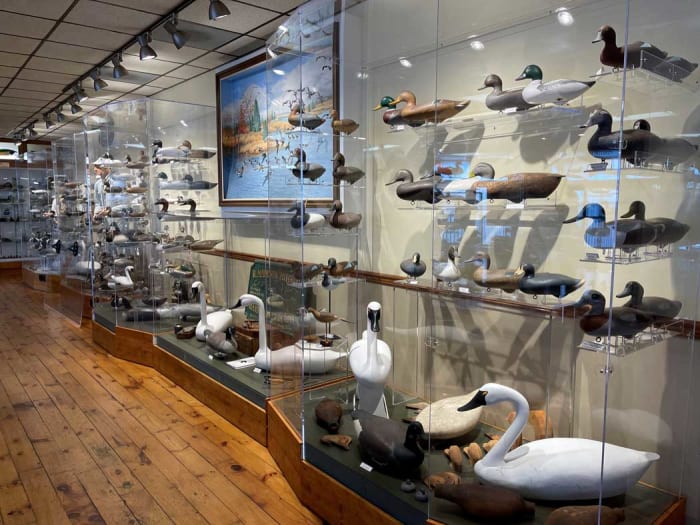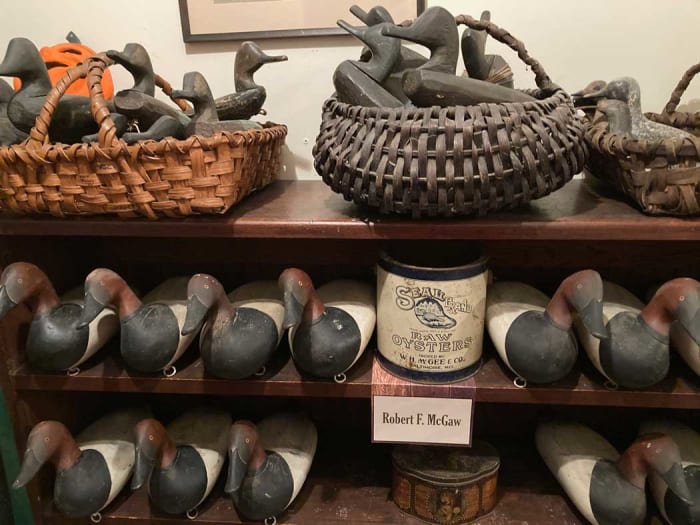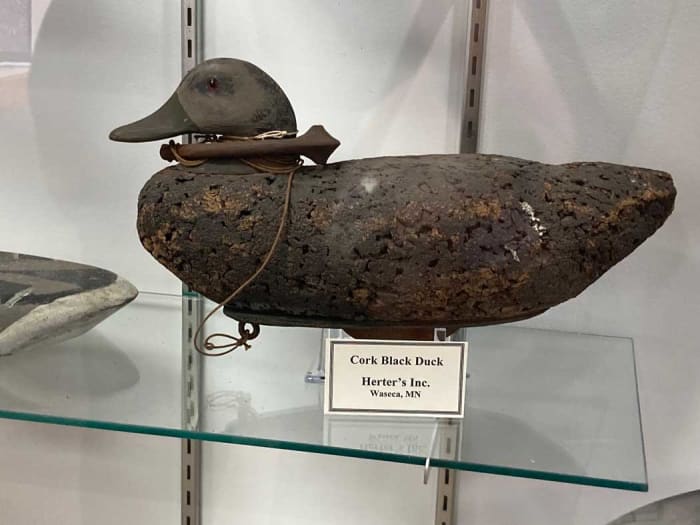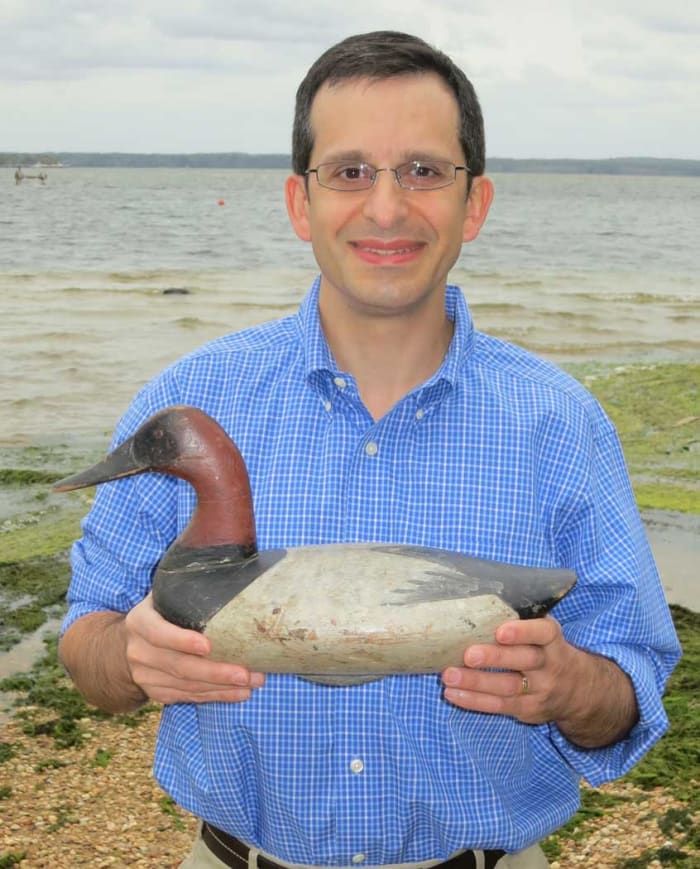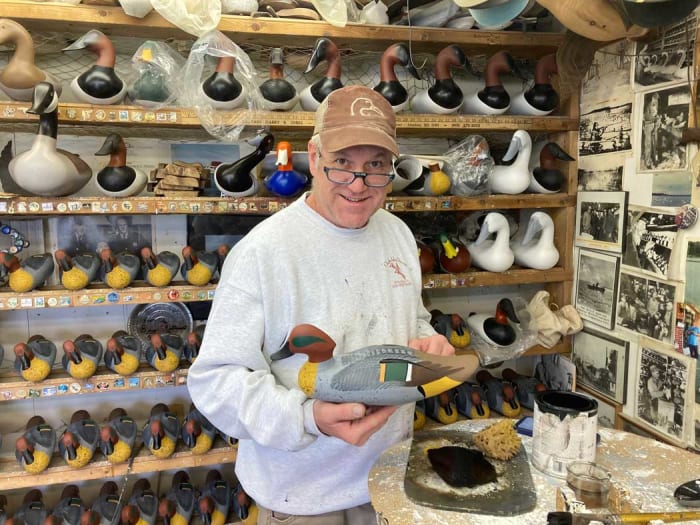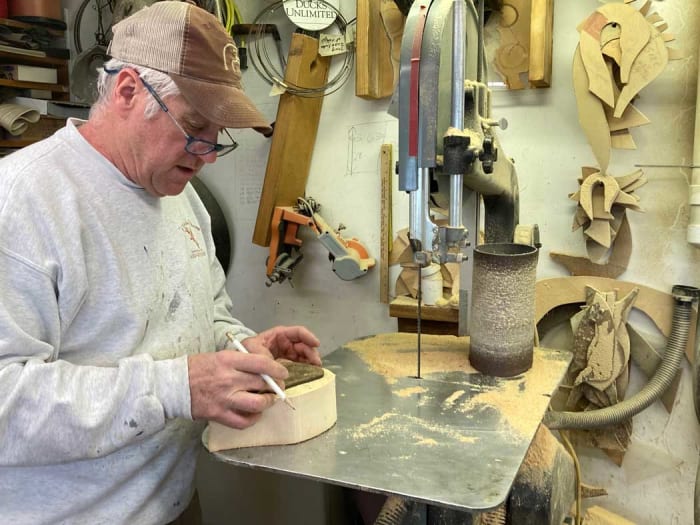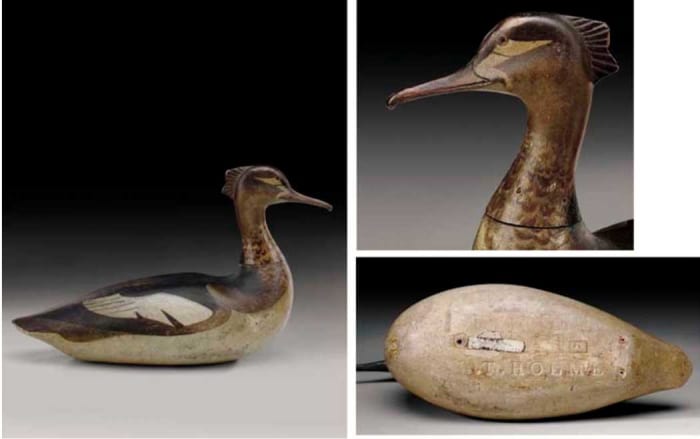#Carving #Decoy #Tradition
Swooping down the Atlantic Flyway from the cold of Canada each fall, endless flocks of colorful ducks and geese migrate to the warmer Susquehanna Flats of the Upper Chesapeake Bay. The small dabbling green-winged teals and the large Canada geese fly to nest for winter. Thousands of waterfowls, such as the greater scaup, redheads, and most importantly, the canvasbacks, land in Maryland’s shallow waters to feed on the lush grasses and celery seed.
In the nineteenth and early twentieth century, the birds so blanketed the sky that hunters flocked to the city of Havre de Grace at the mouth of the Susquehanna River and the head of Chesapeake Bay to shoot for sport and profit.
As duck hunting flourished so did the local carvers, who early on hand-chopped duck decoys for the growing sport. But over the years the grass beds fell to pollution, the big flocks of ducks were depleted by overshooting and lack of habitat and laws were stiffened to protect remaining waterfowl. Residents of Havre de Grace, wanting to preserve the hunting and decoy heritage of the area, launched the Havre de Grace Decoy Museum and the annual Decoy & Wildlife Art Festival to support the museum.
In 1985, the Mayor and City Council, proud of the two successful ventures and the attention both were bringing, formally declared Havre de Grace the “Decoy Capital of the World.” On November 2, 1986, R. Madison Mitchell, the city’s most respected decoy carver, cut the ceremonial ribbon to open the museum.
Located on the banks of the historic Susquehanna Flats, the Havre de Grace Decoy Museum houses one of the finest collections of working and decorative Chesapeake Bay decoys assembled.
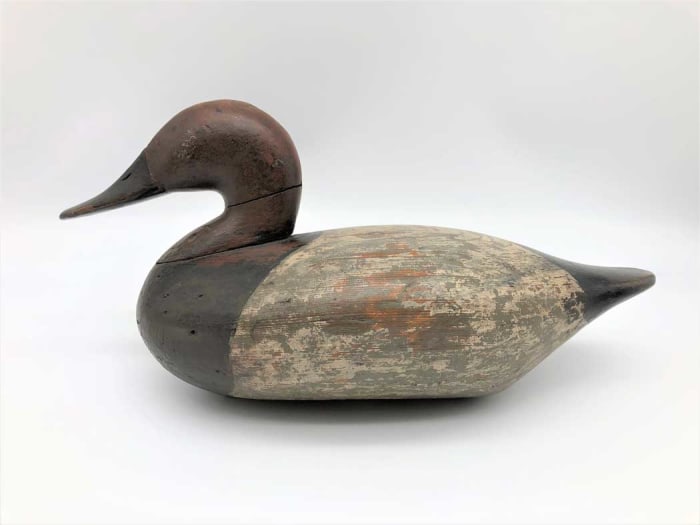
A canvasback decoy by John “Daddy” Holly, the first known carver of what was to become the Havre de Grace style of decoys. From the collection of Chad Tragakis.
Courtesy Chad Tragakis
The Museum’s main gallery exhibit, entitled “What is a Decoy,” points to the soul of Havre de Grace. The exhibit tells the story of an American folk-art tradition, recounts how talented men carved “floating sculpture” and contains examples of working decoys from various flyway regions. Other exhibits include “Gunning the Flats,” which explores the history of waterfowling on the Susquehanna Flats, an area long noted for its bounty of waterfowl, and “Carvers Gallery,” which uses the entire second floor gallery to showcase the work of prominent carvers.
The word “decoy” is derived from the Dutch, who brought to New Amsterdam in America an ancient method of using cages with tame ducks to lure wild fowl to be trapped. The Dutch referred to the duck cage as “eendenkooi.”
Carvers today mostly craft wooden decoys, but Native Americans at least 2,000 years ago bound together tule stems to create decoys. The museum displays a 1997 goose tule decoy by Joe Allen, a member of the Fallon Paiute-Shoshone Tribe from Nevada.
Centuries later, in Havre de Grace, hunters used wooden decoys. By the 1900s, they sold their kill for $5 for a pair of ducks, shipping barrels of ducks up the coast. European immigrants particularly liked the delicacy, the noble canvasback, the “King of Ducks.” President Grover Cleveland and baseball great Babe Ruth joined in the hunt.
Many decoy carvers at the time had limited funds. “They would use any material that floated down the river and telephone poles,” said museum board member John Currier, great-nephew of master local decoy carver, James Currier.
Following WWI, people wanted cheaper decoys. Factory-made decoys made out of cork, canvas, and paper mâché were tried, with little luck. Wooden decoys prevailed, securing Havre de Grace’s place in carving history. An entire school of carving emerged from the Susquehanna Flats area, with Madison Mitchell, John “Daddy” Holly, and a host of others influencing generations of carvers. The museum features a diorama with Mitchell and fellow carvers Bob McGaw, Paul Gibson and Lou Klair sitting around a cast-iron stove in McGaw’s decoy shop. So lifelike, the diorama makes a visitor take an ear to their conversation.
The museum also features a replica of a sinkbox, a relic of past hunts. The blind is a coffin-like box meant to conceal a hunter just below the water level. Larger boxes were ten feet long by six feet wide. Depending on the size, the hunter would stand or lay down in the center of the box. Decoys, some made of cast iron and weighing upwards of fifty pounds, submerged the framework of the sinkbox, concealing the hunter. Hundreds of floating decoys, typically Canvasbacks, were dispersed around the framework.
So effective was the sinkbox at disguising the hunter, what with his head down on the level of the decoys, just barely above the surface, that it was banned in the U.S. in 1936, with many states outlawing its use much earlier.
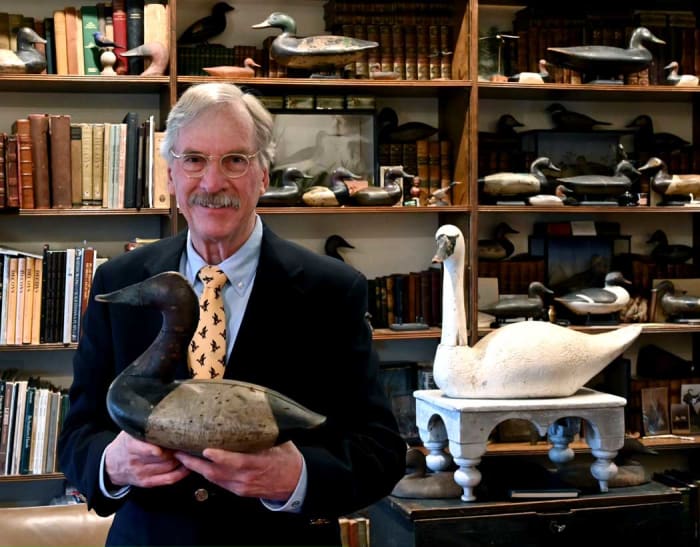
Waterfowl historian and author C. John Sullivan focuses his collecting on decoys from the Susquehanna Flats region. Here he holds a 1918 high neck canvasback decoy by Charles Barnard, a Havre de Grace carver.
“Quite frankly [sinkboxes] were too deadly on the ducks,” said C. John Sullivan, past director of operations of the museum (2011-2013) and recipient of the Presidential Proclamation from Ducks Unlimited. “The end of that era was brought about by the introduction of repeating shotguns. The rapid development of the shotgun changed waterfowling forever. Shotguns transformed from a muzzle loading system to a breech loading system.”
By the 1950s, there were fewer hunters. Carvers created more decoys for show than for hunting, their decoys landing on more fireplace mantels for collectors than water. Upstairs in the “Carvers Gallery,” the museum showcases a slew of incredible decoys from the hands of Capt. Harry Jobes, Bob Litzenberg, James Pierce and others.
The most famous early carver in the museum, Currier said, is Mitchell, who, according to the Spring 2022 Canvasback, the museum’s publication “was one of the most renowned and prolific decoy makers. He is estimated to have made over 100,000 finely crafted decoys and is regarded by some as making the best canvasback decoy on the Chesapeake Bay.”
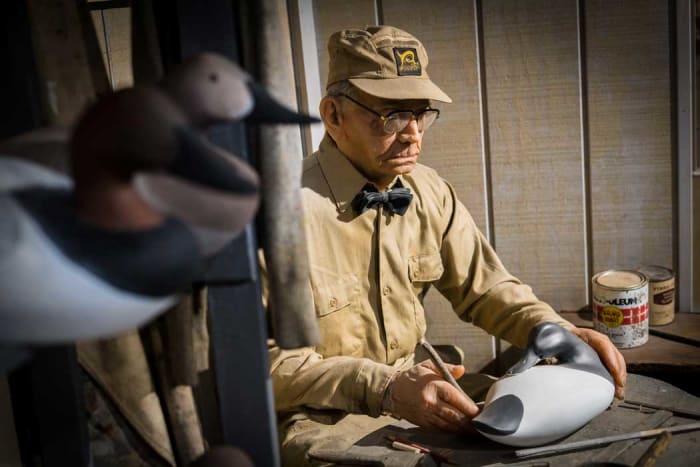
Visitors to the Havre de Grace Decoy Museum can see the R. Madison Mitchell exhibit and view the original workshop exactly as it appeared during his lifetime.
In truth, Mitchell (1901-1993) was the dean of the Upper Chesapeake Bay carvers, by acclamation the top decoy man in Havre de Grace. Mitchell’s canvasbacks, redheads, swans and Canada geese, his black ducks, teal, mallards and other species are as graceful and faithful to the real thing as you’ll ever see.
Mitchell, an undertaker by trade, turned to decoys by accident. His decoy-making cousin, Sam Barnes, helped Mitchell paint his funeral home in 1924, which put Barnes behind on decoy orders. Mitchell returned the favor, helping Barnes make decoys for two years. When Barnes died, leaving a backlog of 1,400 decoy orders, Mitchell stepped into the void – and never looked back.
Mitchell used a duplicating lathe with some of his tools on view on the first floor of the museum. His Christmas ornamental decoys and more tools are in the Carvers Gallery. The rest of his tools are in his shop behind the museum, which the museum would eventually like to bring inside its walls.
Mitchell’s painting became his trademark, particularly the deft finishing strokes to represent wing patches and feathers. His detail work, Sullivan said, is what makes Mitchell’s decoys special. And while Mitchell was detail-oriented, he also had a sense of humor, reflected in a two-headed duck decoy Mitchell made just for fun. The museum proudly displays that, too.
The museum includes a reference library available to researchers, containing over 200 titles, including a fine copy of the rare The Book of Duck Decoys by Sir Ralph Payne-Gallwey (London, 1886).
Today, most of the carvers in Havre de Grace trace their skill of decoy making to the early nineteenth century when John “Daddy” Holly (1818-1892) developed a style of carving unique to the city. His decoys had an upswept tail, round bottom and a regular lead weight – a ring, a staple and tie string to keep it upright and balanced in rough waters. On the other side of the Susquehanna Flats, the Cecil County style, usually credited to John B. Graham, decoys have a paddle tail, flatter bottom, and the head sits higher on the body.
Sullivan, a nationally known author, and historian, said, “Holly is one of my favorite carvers because the decoys are made to look sleek, like they are racing.” He owns Holly decoys and a painting of a sinkbox by Holly. His house is a fascinating museum of its own filled with boats, a sinkbox, guns, shelves of decoys, and sporting items reflecting his vast interest in the hobby.
Chad Tragakis, a writer and regular guest curator for the museum, also loves the decoys of the Holly family. He has been collecting and studying waterfowl decoys for more than thirty years, focusing primarily on the Chesapeake region.
“The evolution of form, their style and the visual presence just get into my soul,” Tragakis said. “When you look at the family and the decoys they produced through a historical and cultural lens, you really see the story of decoys in America.”
His favorite decoy is a swimming mallard drake made around 1890 by James T. Holly (1849-1935), the son of John “Daddy” Holly. “The decoy is in mellow all-original paint and the sculptural form, flowing lines and animated, life-like attitude show the Havre de Grace master decoy maker at the heights of his talents,” Tragakis said. “While it was made as a working decoy, the old greenhead was never rigged or weighted, suggesting its original owner must have recognized early on that the piece deserved to be displayed and appreciated as a work of art, not just a tool of the hunter’s trade. Fortunately, that decision kept the iconic decoy in excellent condition. More than any other, this decoy really speaks to me.”
Today, Capt. Harry Jobes’ sons – Bob, Joey and Charles – carve in the Havre de Grace style. Charles Jobes is the godson of Mitchell. Enter his Havre de Grace shop on Otsego Street and shelves of green-winged teals and ringed-neck decoys greet you ready to be shipped. He has sold to college students two shiny blue decoys with orange heads with Florida Gators on them, their school’s mascot.
Jobes has carved since he was seven. Now 58, and a professional, he works long days at his craft. Newspapers clippings plaster a wall of his workbench area. Wildlife magazines pile high on a shelf. Jobes, like other carvers, lives his passion. He likes to follow the latest news in the waterfowl world. He is active in the biggest wetland conservation group in the world: Ducks Unlimited.
For Sullivan, waterfowl decoys are folk art and need to be appreciated as such. “It is a unique art form to America,” he said.
To watch Jobes create a full-size decoy is to watch an artisan at work. Only a few carvers exist like him in Havre de Grace: Charles Pierce and the Jobes brothers, mainly. “I think my father, myself, and my brothers have been the only family in the U.S. that have carved decoys for a living,” Jobes said. The Jobes and the Pierce family are the grass roots of the decoy makers in Havre de Grace now.
“People don’t realize how long it takes to make a decoy,” Jobes said. If he makes only one decoy at a time from start to finish, it takes him four to five hours; instead, often with his brothers, he creates a dozen heads and bodies before assembling them and painting them.
“A person who knows what they are doing can make about 1,000 decoys a year, but they have a lot of helpers,” he said. He finishes about 500 a year, 85 percent for collectors.
The head of a decoy takes the most time. Jobes uses white pine mostly. A bandsaw cuts out the head. Then Jobes takes his drawknife, pulling it toward himself to “cut away anything that is not a duck,” he said. A drum sander shapes it, putting in eye channels to make the decoy natural-looking.
A whittle knife carves the definition of the duck, giving it personality. Using one piece of wood, Jobes makes a series of V-shaped cuts to make the bill stand out from the head. “A lot of people think the bill is glued on,” he said, “but it’s not.” A belt sander smooths the whole piece.
To make the decoy body, Jobes uses a duplicating lathe to begin shaping a block of wood. The block duplicates the pattern that feeds through the fourteen-inch-carbide tooth blade. Jobes uses a spoke shave to smooth and further shape the wood. He cuts the breast and tail. The drum sander shapes it more. He flattens the top of the body for the head mount, and then glues the head on with epoxy. Lastly, he sands the whole piece and primes it by putting putty in the cracks and painting it. He engraves it with his name and date. Jobes can carve all the waterfowl in North America.
Jobes modern work, which has been shipped as far off as China, resonates with waterfowl fans, yet the vintage working decoys remain popular collectibles. “The antique working decoys have a larger market than the decorative ones,” Currier said, noting a decoy from an 1800s carver of note with original paint, and without buckshot, could be worth $100,000 or more.
Guyette & Deeter, Inc. has handled many of the most important decoy auctions in North America. The auction house sold a mallard drake and hen by Caines Bros. for $1,144,600 in 2018; a feeding plover by Elmer Crowell, for $830,000 in 2003; and, with Christie’s, a merganser hen by Lothrop Holmes for $856,000 in 2007.
“Some collectors focus exclusively on form, others on condition, and many think about monetary value,” Tragakis said. “To me, it’s about the story, the history. Decoys are a great fusion of nature, art, history and Americana. I like to evaluate and approach a decoy from a variety of perspectives. Form, condition, and value are important factors; but the story of where and when a decoy was made, where and how it was used and by whom, for me, these are what bring a wooden bird to life.
“I try to record and document everything I can in the hopes that it will help keep the stories alive. We’re all caretakers of the decoys in our collections, but we’re also caretakers of the history behind them.
“The best advice I received was to buy decoys that speak to you, decoys you are going to love. Whatever the region or maker, whether you collect antique working decoys or contemporary carvings, you should love every bird on your shelf.”
Sullivan focuses his collecting now on decoys from the Susquehanna Flats region. “I realized many years ago that I am only the caretaker of these things for a period of time,” Sullivan said. “My son and grandsons appreciate these artifacts every bit as much as I do. I can rest peacefully knowing that when my time here is done these objects will find a good home with them.”
And so it is, too, with Havre de Grace, where a love of nature, a respect for craft and a duck decoy history has long shared a good home.
You May Also Like:
The Charming World of Beatrix Potter

